6
Designing of Fuzzy Controller for Adaptive Chair and Desk System
Puneet Kundra1, Rashmi Vashisth3*, Ashwani Kumar Dubey2
1Instrumentation and Control Engineering, Amity Institute of Engineering and Technology, New Delhi, India
2Electronics and Communication Engineering, Amity University, Noida, Uttar Pradesh, India
3Electronics and Communication Engineering, Amity Institute of Engineering and Technology, New Delhi, India
Abstract
The purpose of the adaptive chair and desk is to maintain a correct posture for humans of different physical stature while sitting and using a computer system. The fuzzy controller is a precise and economical controller for controlling this type of system. Posture is a very important aspect of physical and mental health, and most of the time, humans are sitting in the wrong posture while using computer systems. Thus, an adaptive system is required which will automatically adjust the chair and the desk on which the computer is kept according to the height of the person who is using the computer at that moment. The art of controlling processes with a degree of autonomy is dependent upon the quality of the intelligent control system being used and the quality of the data or information provided to the control system.
Keywords: Fuzzy logic control, adaptive chair and table, correct posture
6.1 Introduction
The computer has become an integral part of human life: In recent years, electronic games, the home computer system (personal computers), and work stations became an important and fundamental part of our lives, as most of the people are working on personal computers or work stations to earn a livelihood, gain knowledge, and information, acquire new skills and learn new technologies, carry out their research work, play computer games, having video conferencing, and carrying out their businesses online, thus spending a lot of their time sitting in front of computer screens [1]. Also, according to Nicole Fisher’s article in Forbes, an average American adult spends 12 hours a day in front of computer screens [2]. Therefore, it is very important to maintain a proper posture while working or sitting in front of computer screens for such a long period.
Most of the time human beings tend to sit in a wrong manner due to poor habits, chair and body dimensions mismatch, and lack of awareness of correct posture and weak spine which leads to change in humans’ posture continuously after sitting in one posture for quite some time. Further, sitting in the wrong posture leads to a decrease in the blood circulation to the brain, development of carpal tunnel syndrome, lower back pain, a decrease in digestion function, decreases in work efficiency, an increase in fatigue, and creating a sense of negative mood [3].
The list of demerits of sitting in the wrong posture is quite long; these demerits motivate for the development and design of a system that can calculate the correct posture for humans of different statures, so that correct posture is achieved without enormous efforts from the person who is using the computer. With the implementation of an adaptive chair and desk system, the user need not to remind himself again and again that he or she has to sit in the right posture and all the demerits of the sitting in the wrong posture can be avoided.
The user is only required to enter details of his or her physical stature and the system will automatically adapt to the ergonomically specified recommendations for that particular stature using an intelligent control system. In this system, the fuzzy logic controller is employed as it is the knowledge-based control system which is quite comprehended thanks to linguistic terms and well-structured If-Then fuzzy rules. Fuzzy logic control can also employ learning algorithms that it can adopt from other technologies like neural networks or genetic algorithms.
The fuzzy controller is well known for its abilities in automating various conventional systems and processes. It gained success in Japan for its use in home electronic appliances, consumer goods, and automation of various industrial plants. Fuzzy logic minimizes the requirement of human operators (unlike conventional controllers) as human operator’s or process engineer’s knowledge that he has gained by his experiences has been already embedded in the Fuzzy controller in the form of rules, thus providing a higher degree of automation as compared to other conventional controllers at a comparatively lower cost. These features and advantages make the fuzzy controller the most suitable controller for the automation of the chair and desk system.
The knowledge base is the feature of the Fuzzy controller which is the main reason behind the boosted success of the fuzzy logic controllers. Therefore, most accurate knowledge is required about the process or the system which is to be controlled. This knowledge base will lead us to a higher degree of automation and a robust control system. To satisfy this requirement in the adaptive chair and desk system, the knowledge base has been defined by the data harnessed from various sources like U.S. Army Personnel-Anthropometric surveys, furniture designer’s datasheets, office furniture ergonomic records, National Center for Health Anthropometric Reference Data, and records showing the relation between furniture parameters and human body’s dimensions.
This effort has been done to obtain the most accurate data by averaging all the records available for each parameter. Parameters are the variables that define the adaptive chair and desk system. These parameters are varied to adapt according to the body dimension of the person using the adaptive chair and the desk system (desk on which the computer system is placed), achieving a higher degree of automation, a common controller module for each adaptive chair and desk system, and to serve to a much wider audience.
6.2 Time Spent Sitting in Front of Computer Screen
Detail analysis for posture while using computers requires good estimates of time spent by adults and teenagers on computers, so as to justify the requirement of this type of adaptive system. Data used for analysis is obtained from the research paper [1]. The data in Table 6.1 shows the variation in terms of social class, gender, and age.
Data from National Statistics of America was quoted by Nicole Fisher in her article that an average American adult spends 12 hours a day in front of screens. Alysaa Cimino stated that Americans devote more than 10 hours a day to screen time in IST110: Introduction to Information Sciences and Technology.
All these above-stated information reflects that a lot of time of human adults and teenagers is spent in front of screens. Maintaining posture throughout these long-duration periods is very difficult due to unawareness of posture maintenance, weak spine, and poor support from the chair.
Table 6.1 Average screen time spent by different age groups and gender.
| Weekly usage measure | Teenage boys | Teenage girls | Adults boys | Adults girls |
| Percent active per week | 58 | 44 | 37 | 35 |
| Number of Internet sessions | 5.30 | 2.93 | 1.41 | 1.45 |
| Hours online | 4 | 1.51 | 0.82 | 0.57 |
| Session length in minutes | 37.98 | 30.83 | 33.54 | 28.13 |
| Hours on e-mail | 1.70 | 0.84 | 0.25 | 0.22 |
| Percent online time using email | 43 | 56 | 61 | 47 |
| Unique website visited | 11.17 | 3.89 | 4.34 | 1.93 |
This became the principal cause behind the idea of developing a system that could adapt to the dimension or body stature of the person and provides a comfortable position and a correct posture to the person, who is sitting on the chair and using the computer placed on the desk.
6.3 Posture
It is the position assumed by the body or the manner in which the body positions itself whether characteristic or for a special purpose. State or condition is adapted by the body in the given time especially with respect to capability in particular circumstances. During the corona pandemic, every individual is performing his/her job online sitting in front of computer screens, be it, students or adults. Meeting of company personnel, classes of students, research conferences, training, and coaching of new skills and technologies have taken place using computers and the internet while sitting at home [3].
This adaptive system is all about maintaining the correct procedure while the person is sitting and working on the computer. It is a difficult task to constantly focus on your body posture while working or performing your job. An improperly constructed chair that was not designed considering the ergonomics leads to poor postural problems and week spine. This cannot be corrected easily as constant monitoring self posture is not possible. So, an adaptive chair and desk system is required which could adapt to the person’s stature and automatically provides an ergonomic setup so a comfortable position with a perfect posture could be obtained.
6.3.1 Need for Correct Posture
- Reduction in pelvic pain.
- Increased efficiency at work due to better energy levels.
- Fewer tensions felt in the shoulders and neck due to less pressure on inner muscles.
- Risk of abnormal wearing of joint surface decreases.
- Increased lung capacity, thus better breathing.
- A sense of positivity.
- Improved circulation and digestion [3, 4].
6.3.2 Causes of Sitting in the Wrong Posture
- Mismatch of dimensions: Lack of proper fitting chair according to human stature.
- Poor postural habits: People do not maintain a correct posture and later on it becomes their habit.
- Psychological factors: Due to low self-esteem, humans tend to lose his or her posture.
- Awareness: People do not know the need to correct posture.
- Inflexible muscles: The range of the motion is affected.
- Muscle strength: The balance of the body gets affected.
- Lack of posture [4].
6.4 Designing of Ergonomic Seat
At an average 12 hours in a day is spent by Americans while sitting and most of them hate it doing but just do it for the sake of earning a livelihood. Thus, ergonomic chairs are required for a sitting so that workers can sit without pain. As ergonomic chairs are designed for providing immense comfort and help in increasing the efficiency of the person while performing a task [5, 6].
6.4.1 Considerate Factors of an Ergonomic Chair and Desk System
- The Stature of the Person: It is the input variable in this adaptive system, and the most important factor as the rest of the specifications is depending upon the stature only. All the adaptive measures are taken in respect of stature only [7, 8].
- Seat Height Adjustment: Stature varies from person to person, and thus, it plays a keen role in the designing of ergonomic chair which can adapt to persons of different statures. The criteria for obtaining an appropriate seat height depend upon popliteal height, the angle between thighs, and knee to toe, and for obtaining correct measurements, the knees should be kept lower as compared to hips level, while the feet should be placed flat on the ground [7, 9].
- Seat Depth Adjustment: As stature varies from person to person, the buttock to political length also varies from person to person. So, the seat depth is controlled as it provides a proper base to the person sitting on the chair and allows for a proper posture. The depth of the seat is obtained by maintaining 1 to 5 inches between the back of the person’s knee and the seat’s front edge. For this parameter, sinusoidal membership function has been used and data for this function was taken from US Army Personnel—Anthropometric Survey 1988 [8, 9].
- Desk Height Adjustment: Desk is the place where the computer is been kept on. So, the proper height of the desk depending upon stature is very important for posture maintenance and to prevent eye strain, headache, and pain. Standards have been defined for obtaining desk height for a particular height of a person [10, 11].
- Swivel Base: It provides the ability to turnaround while seating on the chair.
- Armrest Height Adjustment: This allows a proper position of armrest according to the person’s stature, so as to provide optimum comfort and maintaining shoulders in a correct posture, thus avoiding pain due to pressure at shoulder level. It should be at level with the desk’s height, as the person requires arms to keep on the armrest in such a way that hands can be appropriately placed on the keyboard so that arms and hands do not feel any kind of strain [12, 13].
- Sitting Eye Height: It is defined to provide an optimum view to the person depending upon the stature of that particular person. This will help in increasing the efficiency of the person and prevent eye strain [14, 15].
All the above explained parameters have been graphically shown in Figure 6.1. The data are shown in Table 6.2 is obtained by averaging data obtained by various research papers of ergonomics and various furniture companies that have designed the algorithms and created calculators for calculating appropriate position [7, 8, 11-16].
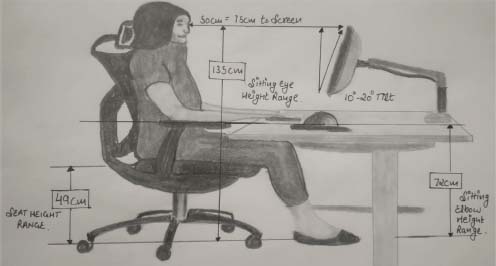
Figure 6.1 Parameters that are controlled by the fuzzy controller.
Table 6.2 Data of different parameters with respect to height of the person.
| S. no. | Height of the person (cm) | Armrest height (cm) | Eye level height (cm) | Desk’s height (cm) | Chair’s height (cm) |
| 1 | 130 | 19 | 100.5 | 52 | 35 |
| 2 | 140 | 21 | 103 | 56 | 38 |
| 3 | 150 | 22 | 106 | 60 | 40 |
| 4 | 160 | 24 | 110 | 65 | 43 |
| 5 | 170 | 25 | 118 | 69 | 46 |
| 6 | 180 | 27 | 126.5 | 73 | 48 |
| 7 | 190 | 28 | 135.5 | 77 | 52 |
6.5 Fuzzy Control Designing
The chair and desk adaptive system works on the fundamental principle of fuzzy logic. Lotfia Zadeh has elaborated on the fundamentals of fuzzy logic [17]. He defined fuzzy logic as a method of filtering data by defining membership set instead of non-membership sets and observed that a fuzzy set induces a possibility distribution on the universe of discourse [18]. It was designed for representing and reasoning with some particular form of knowledge. The knowledge is expressed in a linguistic form and the whole process is operationally powerful; thus, computers are required for the processing [19].
The principle design specification of FKBC includes fuzzification, scaling factors, defuzzification membership function, and denormalization of the data with respect to rule base and data base [20].
The fuzzy controller’s uniqueness is defined by the type of dataset upon which fuzzy controller logic is applied. It uses fuzzy sets formed by grouping data based on the relational function of each element of the fuzzy set which is termed as membership function. This membership function’s value is always between 0 and 1 depending upon the degree of relation [21]. It is unlike conventional controllers that use crisp data values for their functioning.
Crisp input values are provided then normalization or scaling is done for the process of fuzzification which converts crisp values into fuzzy sets on the basis of the rule base.
The main aim is to adapt various parameters of chair and table as per the stature of the person, and this process is done with the help of fuzzy logic controller the parameters that help in correcting the posture of the person can be adjusted by entering the stature of the person. As various proportionality factors have been developed to find appropriate values for chair height, desk height, armrest height, seat depth using the height of the person, and various equations to find appropriate output values. The fuzzy logic decides at a certain period of time and produced different commands according to different inputs. In the below block diagram, a simple fuzzy logic system has been described for controlling seat parameters. Figure 6.2 shows the implementation of fuzzy logic controller for the ACD system and in Figure 6.3 block diagram representation of the system has been shown.

Figure 6.2 Input/output block in fuzzy logic control for adaptive chair and desk system.

Figure 6.3 Block diagram of the fuzzy logic controller.
6.5.1 Fuzzy Logic Controller Algorithm [20]
Algorithm of the fuzzy controller with which it can adapt to the changing environment is shown in the Table 6.3.
Table 6.3 Algorithm of fuzzy logic controller.
| S. no. | Processes involved |
| 1 | Linguistic variable definition |
| 2 | Membership function creation |
| 3 | Rule base definition |
| 4 | Conversion of crisp non-fuzzy values to fuzzy values on the basis of the membership function definition |
| 5 | Evaluating the rules |
| 6 | Combination of the results corresponding to a particular rule |
| 7 | Defuzzification, i.e., conversion of fuzzy values to crisp values |
6.5.2 Fuzzy Membership Functions
Membership functions play a vital role in the process of fuzzification and defuzzification. Membership functions help in creating a relation between the crisp input values and fuzzy linguistic variables or terms [21]. It helps the controller to make precise decisions on the basis of appropriate crisp values provided as input.
In this process, real crisp values are translated into fuzzy values. After these translations, the possible outcomes are called linguistic terms. Membership functions make the fuzzy logic an adaptive and efficient learning controller [19].
Figures 6.4 to 6.8 and Tables 6.4 to 6.8 show the description of all the membership functions used in this system.
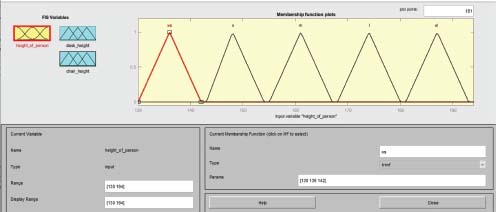
Figure 6.4 Membership function for the height of the person.

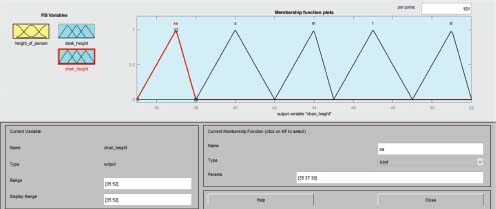
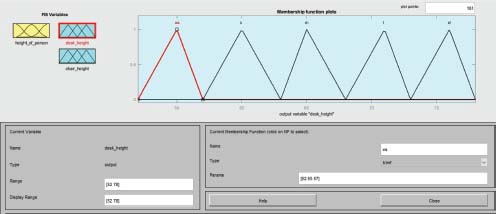
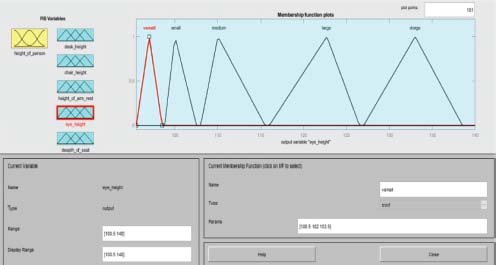
6.5.3 Rule Base
Once fuzzification is done, the next step is to make a decision or deciding what command or action is required to be taken for optimum manipulations to adapt to the varying stature of the person. The definition of rules is given by the “IF “and “THEN” approach [19].
The situation is depicted by the IF part is known as rule antecedent and the resulting reaction is defined by the THEN part which is known as the rule consequent part. The Rule Base is the part of the knowledge block, which includes the knowledge base and rule base [22].
Table 6.4 Membership function for the height of the person.
| 1 | 130 to 142 | Extra Small (XS) |
| 2 | 143 to 155 | Small (S) |
| 3 | 156 to 168 | Medium (M) |
| 4 | 169 to 181 | Large (L) |
| 5 | 182 to 194 | Extra Large (XL) |
| S. no. | Crisp values for chair height (output) | Fuzzy linguistic value set |
| 1 | 35 to 38 | Extra Small (XS) |
| 2 | 38 to 42 | Small (S) |
| 3 | 62 to 45 | Medium (M) |
| 4 | 45 to 49 | Large (L) |
| 5 | 49 to 52 | Extra Large (XL) |
| S. no. | Crisp values for armrest height | Fuzzy linguistic value set |
| 1 | 19 to 21 | Extra Small (XS) |
| 2 | 22 to 23 | Small (S) |
| 3 | 23 to 25 | Medium (M) |
| 4 | 25 to 27 | Large (L) |
| 5 | 27 to 28 | Extra Large (XL) |
| S. no. | Crisp values for desk height (cm) | Fuzzy linguistic value set |
| 1 | 52 to 57 | Extra Small (XS) |
| 2 | 57 to 63 | Small (S) |
| 3 | 43 to 68 | Medium (M) |
| 4 | 68 to 73 | Large (L) |
| 5 | 73 to 78 | Extra Large (XL) |
Table 6.8 Membership function for the eye height level.
| S. no. | Crisp values for eye height level | Fuzzy linguistic value set |
| 1 | 100.5 to 103.5 | Extra Small (XS) |
| 2 | 103.5 to 107.5 | Small (S) |
| 3 | 107.5 to 115.5 | Medium (M) |
| 4 | 115.5 to 126.5 | Large (L) |
| 5 | 126.5 to 138.5 | Extra Large (XL) |
Table 6.9 Rule base for the adaptive chair and desk system.
| S. no. | Fuzzy rules for the system |
| 1 | If (height_of_person is xs), then (desk_height is xs) (chair_height is xs)(height_of_arm_rest is vlow)(eye_height is vsmall)(deapth_of_ seat is xs) |
| 2 | If (height_of_person is s), then (desk_height is s)(chair_height is s) (height_of_arm_rest is low)(eye_height is small)(deapth_of_seat is s) |
| 3 | If (height_of_person is m), then (desk_height is m)(chair_height is m)(height_of_arm_rest is mid)(eye_height is medium)(deapth_ of seat is MID) |
| 4 | If (height_of_person is l), then (desk_height is l)(chair_height is l) (height_of_arm_rest is high)(eye_height is large)(deapth_of seat is l) |
| 5 | If (height_of_person is xl), then (desk_height is xl)(chair_height is xl)(height_of_arm_rest is xl)(eye_height is vlarge)(deapth_of_seat is XL) |
The rule base is present in the knowledge base. These If-Then statements are saved as fuzzy prepositions and whenever the controller finds an input similar to the antecedent part, it chooses the corresponding consequent part of the rule [23]. Table 6.9 shows the rule base used for the optimization of the adaptive chair and desk system.
6.5.4 Why Fuzzy Controller?
- ■ Fuzzy controller is a real-time controlling mechanism in which employees process engineer’s or human operator’s knowledge, which he has obtained by his experiences [24]. This knowledge is implemented in terms of rules or situations and is not expressed easily in terms of differential equations or conventional controller parameters [22].
- ■ In an adaptive chair and desk system, knowledge about various parameters on which the functioning of the system depends was available in abundance [25], thus fuzzy logic controller became the appropriate choice in comparison with other controllers because the whole process could be controlled with a few linguistic rules and provides a fast and real-time response.
- ■ The fuzzy controller has attained a boosted success in controlling small, micro-controller bassed white goods and household appliances [23].
- ■ The fuzzy logic controller is comprehensible due to its well structured If-Then rules and linguistic values and variables [22, 26]. This feature helps a lot in the controller designing process as the designer can easily understand the functioning of the controller unlike neural networks [27].
- ■ Fuzzy logic due to its intellectual linguistic rules can be married to neural networks to form neuro-fuzzy (N-F) networks. N-F networks have both the intellectual linguistic structure and learning capabilities [28, 29].
- ■ Genetic algorithms can also be used in conjugation for searching and optimization purposes [30].
- ■ Fuzzy logic controller focuses on the state transitioning situations in a system that is under control rather than the processes involved in the system [30]. This became the major reason for its selection as a controller in the adaptive chair and control system, as in this system, the controller is required to primarily concentrate on adapting to the body dimension which varies from person to person.
- ■ In the mind of people of European countries and Japan, the name “fuzzy controlled” has positive sentiments attached with it; hence, a sense of security, safety, and longevity with respect to the product are observed in people while buying and using fuzzy controlled goods [31].
- ■ Fuzzy controllers provide robust systems, as the controller mechanism can identify noises and prevents it from affecting the performance of the system [32].
- ■ Designing and maintenance time is considerably less than other controllers due to the presence of two abstracted levels and both having linguistic terms that are understandable to the designers and also to the process engineer [33], thus saving time and money as the communication gap between control designers and process engineers is negligible thanks to the linguistic rules and values.
6.6 Result of Chair and Desk Control
The surface diagram of each parameter with respect to the height of the person is shown in Figures from 6.9 to 6.12. The height of the person in the case study is as follows:
Input:
Height of person = 182 cm
Membership function used = Extra Large (XL)
Output:
Membership function equiped = Extra Large
Height of chair = 50.5 cm
Height of desk= 75.5 cm
Height of arm rest = 27.5 cm
Height of eye level = 133 cm
Width of seat =44 cm
These outputs are shown in Figure 6.13.
6.7 Conclusions and Further Improvements
- ■ In this paper, the fuzzy controller was trained to work similarly to the modernized chair and desk which can adapt according to the stature of the person who is currently occupying the chair and using the computer system which has been kept on the desk. Membership function plays an important role in a fuzzy control system; accurate and detailed membership functions help in reducing errors in the final trained model of the system.
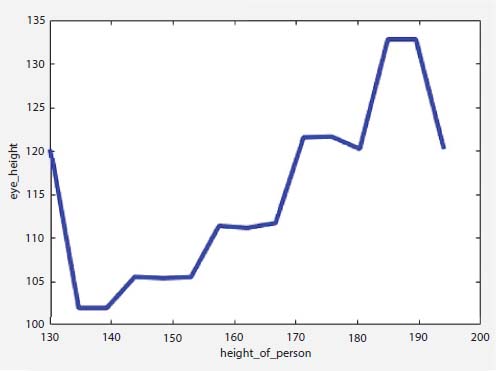
Figure 6.9 Surface view of eye height level.
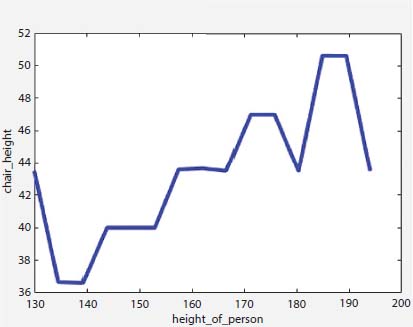
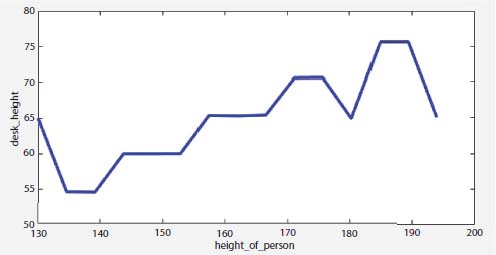
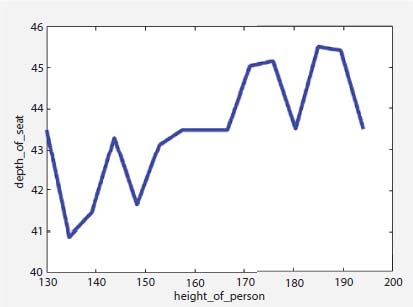
Figure 6.12 Surface view of seat depth.

Figure 6.13 Rule view of the complete adaptive system, showing results for the person height (input) = 182 cm.
- ■ Adaptive chair and desk systems are important for workplaces because people of different statures use similar work station setups [34].
- ■ The fuzzy controller is an intelligent controller and it works more efficiently as compared to conventional controllers due to the presence of fuzzification of inputs and outputs which allows the system to work upon complex functions and controller keeps adapting according to the ever-changing environment.
- ■ The learning process of the adaptive system can be made continuous by encouraging users to enter the feedback after using the adaptive chair and desk system [31]. This feedback can be used for learning using N-F networks [32], thus improving the system throughout its life and providing the benefits of this system to a wider audience.
- ■ Memory features can also be integrated into this system, similar to that of automobile seats, [35] which will enable the users to use this setup without providing inputs again and again rather they can simply assign a number to a user, and the system will remember the settings related to the user number.
- ■ The performance of the fuzzy logic controller in the adaptive chair and desk system is quite accurate but not perfect.
- ■ The main reason behind some cases of failure in this adaptive system is that the length of human body parts varies in humans. For example, buttock_ popliteal length may vary in two humans even if those two humans have the same stature.
- ■ Demerits of the wrong posture could be corrected using adaptive chairs which works upon the data collected from various surveys to find an appropriate table and chair height for people of different heights. Awareness of correct posture should be made so that people can inherently improve their postures.
- ■ People should try to decrease their on-screen times as it is increasing at an alarming rate, and it is hazardous for personal health and mental hygiene and for the whole society.
- ■ ‘J his work can even be extended to cars, buses, and trucks for obtaining correct postures for drivers, i.e., adaptive driving seats, designing ergonomic driving seats for pregnant women.
- ■ In this research paper, we have come to a conclusion that the automatic system works quite well, but still, manual adjustment options should be provided, as sometimes, the automatic system may adjust the chair in a way that user could find the position to be too upright and the lengths of body parts varies even if stature is similar.
References
1. Subrahmanyam, K., Greenfield, P., Kraut, R., Gross, E., The impact of computer use on children’s and adolescents’ development. J. Appl. Dev. Psychol., 22, 1, 7–30, 2001, https://doi.org/10.1016/S0193-3973(00)00063-0.
2. Roberts, N., How Much Time AmericansSpend In Front Of Screens Will Terrify You, Forbes Media, Washington Blvd, Jersey City, NJ 2019, January, https://www.forbes.com/sites/nicolefisher/2019/01/24/how-much-time-americans-spend-in-front-of-screens-will-terrify-you/?sh=2143793a1c67.
3. BURT, Chiropractic Care and Correction of a Bad Posture, United States, Burt Chiropractic Rehabilitation Center, San Leandro, CA, 2016, http://www.burtchiropractic.com/2016/03/08/chiropractic-care-and-bad-posture/.
4. Healthbeat., Why good posture matters, Boston, MA, United States, pp. 1–2, Harvard Health, 2018, https://www.health.harvard.edu/staying-healthy/why-good-posture-matters.
5. Mitchell, K.B., Choi, H.J., Garlie, T.N., Anthropometry and range of motion of the encumbered soldier, U.S. Army Natick Soldier Research, Development and Engineering Center Natick, Massachusetts, 2017, April 2012.
6. Saba, B., Yesus, G.G.G., Singh, A.P., Woyessa, G.K., Seid, S., Ergonomics Assessment of Passenger Seats of Minibuses in Ethiopia. Global J. Res. Eng. Ind. Eng., 13, 1, 7, 2013.
7. humanSolution., Ergonomic Office Desk, Ergonomic Chair, and Keyboard Height Calculator, n.d., Human Solution & Uplift Desk Showroom (Office Furniture), Austin, TX https://www.thehumansolution.com/ergonomic-office-desk-ergonomic-chair-and-keyboard-height-calculator/.
8. Ismaila, S.O. and Akanbi, O.G., Relationship between Standing Height and Popliteal Height. International Conference on Industrial Engineering and Operations Management, 2008–2011, 2012.
9. LifeSpan., Treadmill Desk and Standing Desk Ergonomics, Lifespan US, 2014, https://www.lifespanfitness.com/workplace/resources/articles/treadmill-desk-ergonomics.
10. Fryar, C.D., Gu, Q., Ogden, C.L., Flegal, K.M., Anthropometric Reference Data for Children and Adults: United States, 2011–2014. Vital Health Stat. Ser. 3, Analytical Studies, 39, 1–46, 2016.
11. Fryar, C.D.C., Gu, Q., Ogden, C.L., Flegal, K.M., McDowell, M.A., Fryar, C.D.C., Ogden, C.L., Flegal, K.M., Anthropometric Reference Data for Children and Adults : United States. Vital Health Stat., 11, 251, 2007–2010, 2010, http://www.ncbi.nlm.nih.gov/pubmed/19642512%0Ahttp://www.ncbi.nlm.nih.gov/pubmed/25585443%0Ahttp://www.ncbi.nlm.nih.gov/pub-med/28437242%0Ahttp://www.cdc.gov/nchs/data/series/sr_11/sr11_252.pdf.
12. Tr-, N., Gordon, C.C., Mcconville, J.T., Tebbetts, I., Walker, R.a., Anthropometric Survey Of U.S. Army Personnel, in: INC. Yellow Springs, United States Army Natick Research, Development and Engineering Center, Natick, Massachusetts, 1988.
13. Flexispot, Ergonomic Calculator, FLEXISPOT US, Livermore, CA, https://www.flexispot.com/ergonomic-calculator.
14. Baharampour, S., Nazari, J., Dianat, I., Asgharijafarabadi, M., Student’s Body Dimensions in Relation to Classroom Furniture. Health Promot. Perspect., 3, 2, 165–174, 2013, https://doi.org/10.5681/hpp.2013.020.
15. Kim, D., Cho, M., Park, Y., Yang, Y., Effect of an exercise program for posture correction on musculoskeletal pain. J. Phys. Ther. Sci., 27, 6, 1791–1794, 2015, https://doi.org/10.1589/jpts.27.1791.
16. Ansari, S., Nikpay, A., Varmazyar, S., Design and Development of an Ergonomic Chair for Students in Educational Settings. Health Scope, In Press (In Press), 7, 4, 2018, https://doi.org/10.5812/jhealthscope.60531.
17. Zadeh, L.A., Fuzzy Sets. Sci. Direct, 8, 3, 33–353, 1965, https://doi.org/10.1016/S0019-9958(68)90211-8.
18. Driankov, D., Hellendoorn, H., Reinfrank, M., An Introduction to Fuzzy Control, NAROSA PUBLISHING HOUSE, Delhi Medical Association Road Daryaganj, New Delhi, India, 1996.
19. Braae, M. and Rutherford, D.A., Theoretical and linguistic aspects of the fuzzy logic controller. Automatica, 15, 5, 553–577, 1979, https://doi.org/10.1016/0005-1098(79)90005-0.
20. Zadeh, L.A., Fuzzy algorithms. Inf. Control, 12, 2, 94–102, 1968, https://doi.org/10.1016/S0019-9958(68)90211-8.
21. Klir, G. and Yuan, B., Fuzzy Sets and Fuzzy Logic:Theory and Applications, Pearson, Hudson in New York City, New York, 1995.
22. Bernard, J.A., Fuzzy Sets and Fuzzy Logic:Theory and Applications, The Springer International Series in Engineering and Computer Science book series (SECS, volume 457) Springer Nature Switzerland AG, 1988.
23. Ciliz, K., Frei, J., Isik, C., Practical Aspects of the Knowledge-based control of a mobile robot motion. 30th Midwest Symp. on Circuits and Systems, 1987.
24. Yen, J. and Reza, L., Fuzzy Logic: Intelligence, Control, and Information, Pearson, Hudson in New York City, New York, 1999.
25. Omron, Fuzzy Guide Book, Omron Publishing, OMRON Corporation Industrial Automation Company Heita Nada Shiokoji Horikawa Kyoto, Japan, 1992.
26. Zimmermann, H.-J., Fuzzy Set Theory—and Its Applications, in: Fuzzy Set Theory—and Its Applications, 2001, https://doi.org/10.1007/978-94-010-0646-0
27. Ogata, K., Modern control engineering, in: Modern Control Engineering, Prentice-Hall of India, Rimjhim House, Patparganj Industrial Estate, Delhi - India, 1977, https://doi.org/10.1201/9781315214573.
28. IEEE Transactions on Systems, Man, and Cybernetics Fuzzy_Logic_Control_ Systems_II_Lee_1990.pdf, 20, 2, 1990.
29. Maiers, J. and Sherif, Y.S., Applications of fuzzy set theory. IEEE Trans. Syst., Man, Cybern., SMC-15, 1, 175–189, Jan.-Feb. 1985.
30. Chai, Y., Jia, L., Zhang, Z., Mamdani model based adaptive neural fuzzy inference system and its application in traffic level of service evaluation. 6th International Conference on Fuzzy Systems and Knowledge Discovery, FSKD 2009, 4, January 2009, pp. 555–559, 2009, https://doi.org/10.1109/FSKD.2009.76.
31. Guiffrida, A.L. and Nagi, R., Fuzzy set theory applications in production management research: A literature survey. J. Intell. Manuf., 9, 1, 39–56, 1998, https://doi.org/10.1023/A:1008847308326.
32. Li, X. and Huang, T., Adaptive synchronization for fuzzy inertial complexvalued neural networks with state-dependent coefficients and mixed delays. Fuzzy Sets Syst., 2020, https://doi.org/10.1016/j.fss.2020.05.013.
33. Mirzal, A., Approximation and Compensation of Delay in Analog Control Plant. June, Proc. Japan Society for Precision Engineering, Sapporo, Japan, 2015.
34. Taifa, I.W. and Desai, D.A., Anthropometric measurements for ergonomic design of students’ furniture in India. Eng. Sci. Technol., Int. J., 20, 1, 232–239, 2017, https://doi.org/10.1016/j.jestch.2016.08.004.
35. Berenji, H.R., Fuzzy Logic and Neural Networks for Control Systems. IEEE, Educ. Act., Vis. Mater., 3, 5, 1992.
- *Corresponding author: [email protected]
